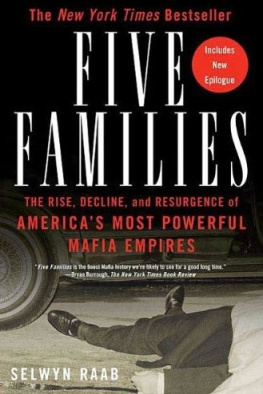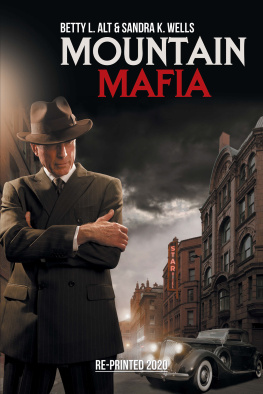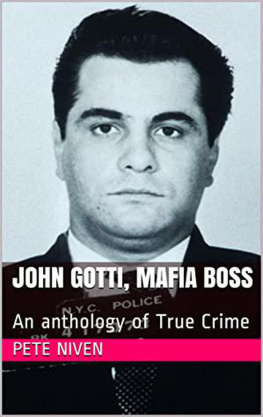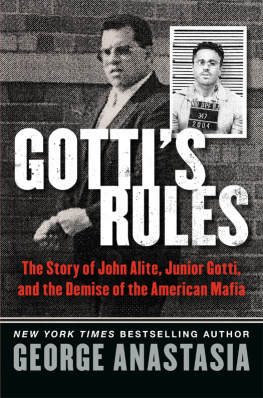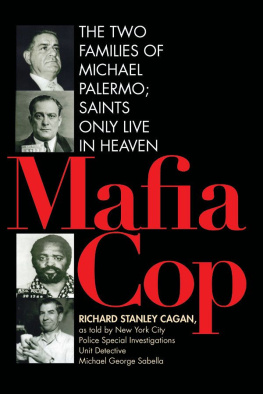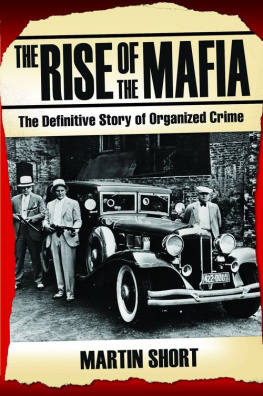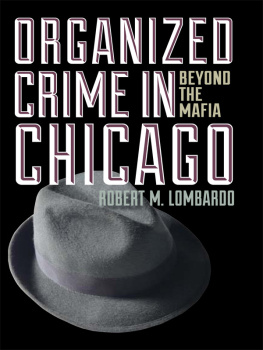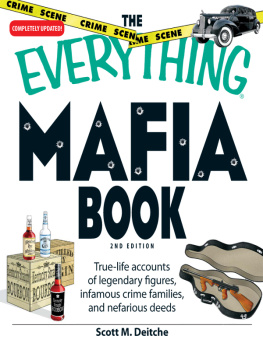Selwyn Raab - Five Families: The Rise, Decline, and Resurgence of Americas Most Powerful Mafia Empires
Here you can read online Selwyn Raab - Five Families: The Rise, Decline, and Resurgence of Americas Most Powerful Mafia Empires full text of the book (entire story) in english for free. Download pdf and epub, get meaning, cover and reviews about this ebook. year: 2006, publisher: St. Martins Press, genre: Home and family. Description of the work, (preface) as well as reviews are available. Best literature library LitArk.com created for fans of good reading and offers a wide selection of genres:
Romance novel
Science fiction
Adventure
Detective
Science
History
Home and family
Prose
Art
Politics
Computer
Non-fiction
Religion
Business
Children
Humor
Choose a favorite category and find really read worthwhile books. Enjoy immersion in the world of imagination, feel the emotions of the characters or learn something new for yourself, make an fascinating discovery.
- Book:Five Families: The Rise, Decline, and Resurgence of Americas Most Powerful Mafia Empires
- Author:
- Publisher:St. Martins Press
- Genre:
- Year:2006
- Rating:3 / 5
- Favourites:Add to favourites
- Your mark:
- 60
- 1
- 2
- 3
- 4
- 5
Five Families: The Rise, Decline, and Resurgence of Americas Most Powerful Mafia Empires: summary, description and annotation
We offer to read an annotation, description, summary or preface (depends on what the author of the book "Five Families: The Rise, Decline, and Resurgence of Americas Most Powerful Mafia Empires" wrote himself). If you haven't found the necessary information about the book — write in the comments, we will try to find it.
Selwyn Raab: author's other books
Who wrote Five Families: The Rise, Decline, and Resurgence of Americas Most Powerful Mafia Empires? Find out the surname, the name of the author of the book and a list of all author's works by series.
Five Families: The Rise, Decline, and Resurgence of Americas Most Powerful Mafia Empires — read online for free the complete book (whole text) full work
Below is the text of the book, divided by pages. System saving the place of the last page read, allows you to conveniently read the book "Five Families: The Rise, Decline, and Resurgence of Americas Most Powerful Mafia Empires" online for free, without having to search again every time where you left off. Put a bookmark, and you can go to the page where you finished reading at any time.
Font size:
Interval:
Bookmark:

Mob Lawyer (with Frank Ragano) Justice in the Back Room

The Rise, Decline, and Resurgence of Americas Mast Powerful Mafia Empires
Selwyn Raab

THOMAS DUNNE BOOKS St. Martins Press
 New York
New YorkFIVE FAMILIES. Copyright 2005 by Selwyn Raab. All rights reserved. Printed in the United States of America. No part of this book may be used or reproduced in any manner whatsoever without written permission except in the case of brief quotations embodied in critical articles or reviews. For information, address St. Martins Press, 175 Fifth Avenue, New York, N.Y. 10010.
www.stmartins.com
ISBN 0-312-30094-8
EAN 978-0-312-30094-4
10 9 8 7 6 5 4
and my grandson, William Raab Goldstein:
May fortune bestow upon him his namesakes integrity
and zest for life.

 E veryone I know in the New York area has brushed up against the American Mafia at one time or another. Most were unaware of it.Over the greater part of the twentieth century and into the new millennium, the Mafia, aka the Cosa Nostra and the Mob, generated a toxic effect on the lives of all New Yorkers and untold millions of Americans from coast to coast, surreptitiously rifling our pockets and damaging our overall quality of life. Much of the nation unwittingly subsidized in myriad ways the nations five most powerful and traditional Cosa Nostra organized-crime gangs, all based in New York, who prefer the warmer title of families.From their New York headquarters, the families collectively created a vast domain, establishing outposts along the East Coast and in plum spots in Florida, California, and elsewhere. One of their sweetest financial coups was pioneering the secret acquisitions of big-time casinos in Las Vegas, converting a drowsy desert town into an international gambling mecca.Unquestionably, the gangs known as the Bonanno, Colombo, Gambino, Genovese, and Lucchese crime families evolved into the reigning giants of the underworld. For decades, they alone possessed the authority and veto power to dominate many of the countrys other Mafia organizations, reducing some to virtual satellites.New Yorkthe Cosa Nostras crown jewelsupported them through indirect Mob taxes on the purchases of clothing and basic foods like vegetables, fruit, fish, and meat. They siphoned handsome illegal profits when drivers filled up at gasoline pumps. They controlled waterfront commerce in the countrys largest port. They preyed on our garbage, inflating the cost of discarding every piece of refuse from homes and work sites. They cashed in on a billion-dollar construction industry, extracting payoffs from major government and private projects, ranging from courthouses to suburban housing tracts, apartment complexes, hospitals, museums, and skyscrapers. They even profited from their arch law-enforcement enemies by squeezing kickbacks from the builders of new FBI offices, police headquarters, and prisons.The human cost of the Mafias depredations and plunder is incalculable. Their chieftains were directly responsible for the widespread introduction of heroin into cities of the East and Midwest in the late 1950s and early 60s. Other less organized criminal groups, witnessing the enormous profits spawned by drug trafficking, followed in their footsteps. But it was the Cosa Nostras greed for narcotics dollars that accelerated crime rates, law-enforcement corruption, and the erosion of inner-city neighborhoods in New York and throughout the United States.My first journalistic collision with the Mafia arose from an unexpected quarterNew York Citys public school system. That introduction, however, reflected the Mobs insidious influence in so many shadowy areas of big-city existence.In the early 1960s, my assignment as a new reporter on a major newspaper, the old New York World-Telegram and The Sun , was the education beat. I normally wrote about issues like declining reading and mathematics test scores, attempts to unionize teachers, and racial integration disputesuntil I was pulled away by a mini scandal concerning shoddy construction and renovations that were endangering the safety of thousands of students and teachers in their classrooms. There was stark evidence of crumbling roofs, walls, floors, electrical fire hazards, and one instance of sewage mixing with drinking water in a high school. All of these violations stemmed from inferior, substandard materials and installations provided for years by a small clique of companies.Digging into the backgrounds of the building-trades companies unearthed an unwholesome pattern: many firms had unlisted or phantom investors who were connected to Mob families. Much of the low bidding competition for lucrative school jobs apparently had been rigged by the Mafia to balloon profits through a gimmick called changed orders.School officials responsible for construction and contract oversight were fired or abruptly quit, and negligent contractors were banned from future school work. But not a single mafioso involved in the mess was indicted. The reason: officials retreated, saying there were no clear paper trails incriminating mobsters in money skimming; and no contractor had the courage to testify about the Mobs role in the scandal. In short, the Mafia endangered thousands of children and escaped unscarred, with its loot untouched.Later as an investigative newspaper and television reporter, I kept running across the Mafias fingerprints on numerous aspects of government, law enforcement, unions, and everyday life.There were stories of mobsters introducing and overseeing heroin trafficking in Harlem. Without strong police interference, blue-collar neighborhoods were destabilized and turned into drug souks.There was the ordeal of George Whitmore, a black teenager framed for a triple murder and wrongly imprisoned for years, with the help of rulings by a judge appointed through the support of Mafia bosses.There was the exposure of perfectly fit mafiosi obtaining Disabled Driver permits that allowed them to park almost anywhere in the congested city. Their redundant friends at police headquarters authorized the valuable permits.There was the chronic intimidation of Fulton Fish Market merchants who were compelled to fork over protection payments to mobsters to avoid daily harassment of their business operations.And, there were the uphill struggles of honest painters, carpenters, and teamsters, who were brutally assaulted when they spoke up at union meetings about mobsters taking over their locals and ripping off their welfare and pension funds.It required little sagacity for a reporter to determine that, by the 1970s, the Mafia operated as a surrogate state in the New York metropolitan area, brazenly dominating vital businesses and imposing its farrago of invisible surcharges on everyone. In fact, the Mobs economic surge in the second half of the century was astonishing. A government analysis estimated that, in the 1960s, the illicit profit of the nations twenty-odd Mafia families topped $7 billion annually, approximately the combined earnings of the ten largest industrial corporations in the country. The lions share of the illicit wealth was reaped by the most powerful segment of the Cosa Nostra conglomeratethe five New York gangs.For much of the twentieth century New Yorks municipal and law-enforcement authorities seemed indifferent to these criminal inroads. Questioned in the 1970s about the Mafias sway, officials privately conceded that previous attempts to dislodge them had been largely futile and there was no public outcry for similar meaningless crackdowns. Then, too, the authorities felt that the public largely tolerated mafiosi as unthreatening to the general population, viewing them as a loosely organized group engaged largely in nonviolent crimes like bookmaking and operating popular neighborhood gambling dens.The apologists contended that strict regulatory enforcement of the wholesale food, construction, and garbage-carting industries might produce severe economic headaches. City Hall and many law-enforcement agencies tacitly subscribed to a laissez-faire accommodation with the Mob. Almost everyone in power was content so long as food supplies reached restaurants and supermarkets, construction projects were completed, and refuse was picked up on schedule. A consensus decreed that so long as there were no incessant complaints, there was no reason to stir up trouble about mobster involvement in producing basic necessities.Far too long, the majority of media editors were of a similar mind with officialdom. They preferred reporting on the occasional sensational homicides or internecine Mob wars in place of costly long-range inquiries to document Cosa Nostras economic clout and its manipulation of municipal agencies. A sizable part of the media preferred glamorizing mobsters as an integral and colorful segment of New Yorks chaotic texture. Despite their criminal records and suspected participation in multiple murders, John Gotti, Joey Gallo, and Joe Colombo were accorded celebrity status and often portrayed not as merciless killers but as maverick, antiestablishment folk heroes.Indeed, a commonly recycled story by newspapers and television subtly praised the Mafia, citing its formidable presence for low street-crime rates in predominantly Italian-American sections. With predatory crime soaring, two Mafia strongholds, Manhattans Little Italy and Brooklyns Bensonhurst, were presented as safe havens to live in. Unreported and underemphasized were the factors behind these statistics. Significantly, the gangsters relied on sympathetic neighborhood residents to alert them to the presence of probing law-enforcement agents and suspicious outsiders trying to encroach on their bastions. These watchdogs helped turn their neighborhoods into xenophobic enclaves, sometimes resulting in violence against strangers, especially African-Americans and Hispanics.The legend about security in Mafia-tainted neighborhoods still prevails in the new century. A friend in the suburbs expressed his relief about his daughters move to New York because she had found an apartment in a safe part of the cityLittle Italyprotected by local Mob guys.The world of organized crime is totally unlike any other journalistic beat, Accurate, documented data about the Mafias clandestine activities usually is difficult to verify. The five families never issue annual financial reports, nor do their bosses happily consent to incisive personality profiles. Over more than four decades, I compiled information piecemeal, combing through a variety of public and confidential records, court transcripts, real estate transactions, and files from federal and state law-enforcement agencies obtained through Freedom of Information laws.There were also interviews with scores of active and former investigators, highlighted by the late Ralph Salerno, whose encyclopedic knowledge and documentation of the American Mafia remains unchallenged.Then, too, there were the grim details of beleaguered workers resisting Mafia musclemen in control of their unions. Facts about labor rackets were gleaned with the aid of Herman Benson and James F McNamara, two lifelong advocates of union reform, who could locate witnesses to mobster takeovers of their locals. Benson is a founder of the Association for Union Democracy, the principal national civic organization that aids activists battling corruption and organized-crime infiltration in the labor movement. McNamara, a former union organizer, became an expert consultant on labor racketeering for several law-enforcement agencies.Persuading admitted mafiosi and their helpmates to talk candidly is never easy. I was fortunate in getting several to unravel the Mafias mysterious codes and culture and to elucidate the art of surviving in a volatile criminal environment.One breakthrough in learning about contemporary Cosa Nostra lore and traditions came about obliquely in the early 1980s from a New York Times style rule. A mobster named Pellegrino Masselli was a central figure in a high-profile case about alleged Mafia profiteering from a New York City subway project and a mysterious murder. Most of the press delighted in referring to him by his underworld sobriquet, Butcher Boy. Because the Times prohibits the use of pejorative nicknames, my stories always referred to the gangster with an honorific: Mr. Masselli. Obviously unaware of newspaper etiquette, Masselli, out of the blue, telephoned a compliment for exhibiting proper respect to him in print. He also volunteered to be interviewed in his prison cell about the subway deal and the gangland slaying of his son.That encounter initiated a relationship that lasted until Massellis deathfrom natural causes. Over five years, with the proviso that he would never be identified in new stories, Masselli offered tips on Mafia-related developments and enlightenment on ingrained Cosa Nostra customs. He was particularly revealing about the pathological mind-set of his fellow mobsters and how they judged one anothers conduct. Committing murder might be a horrific act for a normal person, but Masselli explained that a committed mafioso is unperturbed by violence. Moreover, he is applauded by his bosses and colleagues as long as the piece of work is done professionally and competently, even if a hit requires killing a good friend.A lengthy on-the-record interview with another admitted mafioso, Anthony Accetturo, provided unique insight into a veteran Cosa Nostras experiences and thinking. A longtime capo, the head of a crew or unit in New Jersey, Accetturo, after being imprisoned for racketeering, agreed to be questioned and to reminisce freely about his Mob career and his dealings with important mafiosi.Compelling information about the Mafias white-collar activities on Wall Street and other financial crimes came from a Cosa Nostra associate, or helper. Proclaiming himself rehabilitated, he described various schemes inaugurated to fleece investors when the Mafia capitalized on the 1990s stock market mania. His explanation for coming clean was a desire to appease his conscience and to prevent future suckers from being snared in organized-crime financial traps. Whatever his reasons, the information proved to be accurate. To protect him from retaliation, his identity must remain undisclosed.In the last years of his life, Frank Ragano, a self-described Mob lawyer, offered an in-depth narrative of sordid legal and social relationships with prominent mobsters. Before he died, Ragano vowed to atone for ethical shortcomings that led him to defend the Cosa Nostra in court and behind the scenes. Belatedly, he acknowledged that ambition drove him to represent the Mafia as a fast track to wealth and recognition as an important attorney. He supplied unprecedented material on the personalities and machinations of his top clients, two powerful Southern bosses, Santo Trafficante and Carlos Marcello, and their contentious ally, teamsters union chief Jimmy Hoffa. He also knew intimate details of the Mobs hatred and death wishes for President John F. Kennedy and his brother Robert.These recent accounts by Mafia insiders and a legion of defectors, combined with a trove of intelligence reports from the FBI and other law-enforcement agencies, have contributed immensely to the history and comprehension of an underworld phenomenon. The collective goal of the five families of New York was the pillaging of the nations richest city and region. This is the saga of how they did it.
E veryone I know in the New York area has brushed up against the American Mafia at one time or another. Most were unaware of it.Over the greater part of the twentieth century and into the new millennium, the Mafia, aka the Cosa Nostra and the Mob, generated a toxic effect on the lives of all New Yorkers and untold millions of Americans from coast to coast, surreptitiously rifling our pockets and damaging our overall quality of life. Much of the nation unwittingly subsidized in myriad ways the nations five most powerful and traditional Cosa Nostra organized-crime gangs, all based in New York, who prefer the warmer title of families.From their New York headquarters, the families collectively created a vast domain, establishing outposts along the East Coast and in plum spots in Florida, California, and elsewhere. One of their sweetest financial coups was pioneering the secret acquisitions of big-time casinos in Las Vegas, converting a drowsy desert town into an international gambling mecca.Unquestionably, the gangs known as the Bonanno, Colombo, Gambino, Genovese, and Lucchese crime families evolved into the reigning giants of the underworld. For decades, they alone possessed the authority and veto power to dominate many of the countrys other Mafia organizations, reducing some to virtual satellites.New Yorkthe Cosa Nostras crown jewelsupported them through indirect Mob taxes on the purchases of clothing and basic foods like vegetables, fruit, fish, and meat. They siphoned handsome illegal profits when drivers filled up at gasoline pumps. They controlled waterfront commerce in the countrys largest port. They preyed on our garbage, inflating the cost of discarding every piece of refuse from homes and work sites. They cashed in on a billion-dollar construction industry, extracting payoffs from major government and private projects, ranging from courthouses to suburban housing tracts, apartment complexes, hospitals, museums, and skyscrapers. They even profited from their arch law-enforcement enemies by squeezing kickbacks from the builders of new FBI offices, police headquarters, and prisons.The human cost of the Mafias depredations and plunder is incalculable. Their chieftains were directly responsible for the widespread introduction of heroin into cities of the East and Midwest in the late 1950s and early 60s. Other less organized criminal groups, witnessing the enormous profits spawned by drug trafficking, followed in their footsteps. But it was the Cosa Nostras greed for narcotics dollars that accelerated crime rates, law-enforcement corruption, and the erosion of inner-city neighborhoods in New York and throughout the United States.My first journalistic collision with the Mafia arose from an unexpected quarterNew York Citys public school system. That introduction, however, reflected the Mobs insidious influence in so many shadowy areas of big-city existence.In the early 1960s, my assignment as a new reporter on a major newspaper, the old New York World-Telegram and The Sun , was the education beat. I normally wrote about issues like declining reading and mathematics test scores, attempts to unionize teachers, and racial integration disputesuntil I was pulled away by a mini scandal concerning shoddy construction and renovations that were endangering the safety of thousands of students and teachers in their classrooms. There was stark evidence of crumbling roofs, walls, floors, electrical fire hazards, and one instance of sewage mixing with drinking water in a high school. All of these violations stemmed from inferior, substandard materials and installations provided for years by a small clique of companies.Digging into the backgrounds of the building-trades companies unearthed an unwholesome pattern: many firms had unlisted or phantom investors who were connected to Mob families. Much of the low bidding competition for lucrative school jobs apparently had been rigged by the Mafia to balloon profits through a gimmick called changed orders.School officials responsible for construction and contract oversight were fired or abruptly quit, and negligent contractors were banned from future school work. But not a single mafioso involved in the mess was indicted. The reason: officials retreated, saying there were no clear paper trails incriminating mobsters in money skimming; and no contractor had the courage to testify about the Mobs role in the scandal. In short, the Mafia endangered thousands of children and escaped unscarred, with its loot untouched.Later as an investigative newspaper and television reporter, I kept running across the Mafias fingerprints on numerous aspects of government, law enforcement, unions, and everyday life.There were stories of mobsters introducing and overseeing heroin trafficking in Harlem. Without strong police interference, blue-collar neighborhoods were destabilized and turned into drug souks.There was the ordeal of George Whitmore, a black teenager framed for a triple murder and wrongly imprisoned for years, with the help of rulings by a judge appointed through the support of Mafia bosses.There was the exposure of perfectly fit mafiosi obtaining Disabled Driver permits that allowed them to park almost anywhere in the congested city. Their redundant friends at police headquarters authorized the valuable permits.There was the chronic intimidation of Fulton Fish Market merchants who were compelled to fork over protection payments to mobsters to avoid daily harassment of their business operations.And, there were the uphill struggles of honest painters, carpenters, and teamsters, who were brutally assaulted when they spoke up at union meetings about mobsters taking over their locals and ripping off their welfare and pension funds.It required little sagacity for a reporter to determine that, by the 1970s, the Mafia operated as a surrogate state in the New York metropolitan area, brazenly dominating vital businesses and imposing its farrago of invisible surcharges on everyone. In fact, the Mobs economic surge in the second half of the century was astonishing. A government analysis estimated that, in the 1960s, the illicit profit of the nations twenty-odd Mafia families topped $7 billion annually, approximately the combined earnings of the ten largest industrial corporations in the country. The lions share of the illicit wealth was reaped by the most powerful segment of the Cosa Nostra conglomeratethe five New York gangs.For much of the twentieth century New Yorks municipal and law-enforcement authorities seemed indifferent to these criminal inroads. Questioned in the 1970s about the Mafias sway, officials privately conceded that previous attempts to dislodge them had been largely futile and there was no public outcry for similar meaningless crackdowns. Then, too, the authorities felt that the public largely tolerated mafiosi as unthreatening to the general population, viewing them as a loosely organized group engaged largely in nonviolent crimes like bookmaking and operating popular neighborhood gambling dens.The apologists contended that strict regulatory enforcement of the wholesale food, construction, and garbage-carting industries might produce severe economic headaches. City Hall and many law-enforcement agencies tacitly subscribed to a laissez-faire accommodation with the Mob. Almost everyone in power was content so long as food supplies reached restaurants and supermarkets, construction projects were completed, and refuse was picked up on schedule. A consensus decreed that so long as there were no incessant complaints, there was no reason to stir up trouble about mobster involvement in producing basic necessities.Far too long, the majority of media editors were of a similar mind with officialdom. They preferred reporting on the occasional sensational homicides or internecine Mob wars in place of costly long-range inquiries to document Cosa Nostras economic clout and its manipulation of municipal agencies. A sizable part of the media preferred glamorizing mobsters as an integral and colorful segment of New Yorks chaotic texture. Despite their criminal records and suspected participation in multiple murders, John Gotti, Joey Gallo, and Joe Colombo were accorded celebrity status and often portrayed not as merciless killers but as maverick, antiestablishment folk heroes.Indeed, a commonly recycled story by newspapers and television subtly praised the Mafia, citing its formidable presence for low street-crime rates in predominantly Italian-American sections. With predatory crime soaring, two Mafia strongholds, Manhattans Little Italy and Brooklyns Bensonhurst, were presented as safe havens to live in. Unreported and underemphasized were the factors behind these statistics. Significantly, the gangsters relied on sympathetic neighborhood residents to alert them to the presence of probing law-enforcement agents and suspicious outsiders trying to encroach on their bastions. These watchdogs helped turn their neighborhoods into xenophobic enclaves, sometimes resulting in violence against strangers, especially African-Americans and Hispanics.The legend about security in Mafia-tainted neighborhoods still prevails in the new century. A friend in the suburbs expressed his relief about his daughters move to New York because she had found an apartment in a safe part of the cityLittle Italyprotected by local Mob guys.The world of organized crime is totally unlike any other journalistic beat, Accurate, documented data about the Mafias clandestine activities usually is difficult to verify. The five families never issue annual financial reports, nor do their bosses happily consent to incisive personality profiles. Over more than four decades, I compiled information piecemeal, combing through a variety of public and confidential records, court transcripts, real estate transactions, and files from federal and state law-enforcement agencies obtained through Freedom of Information laws.There were also interviews with scores of active and former investigators, highlighted by the late Ralph Salerno, whose encyclopedic knowledge and documentation of the American Mafia remains unchallenged.Then, too, there were the grim details of beleaguered workers resisting Mafia musclemen in control of their unions. Facts about labor rackets were gleaned with the aid of Herman Benson and James F McNamara, two lifelong advocates of union reform, who could locate witnesses to mobster takeovers of their locals. Benson is a founder of the Association for Union Democracy, the principal national civic organization that aids activists battling corruption and organized-crime infiltration in the labor movement. McNamara, a former union organizer, became an expert consultant on labor racketeering for several law-enforcement agencies.Persuading admitted mafiosi and their helpmates to talk candidly is never easy. I was fortunate in getting several to unravel the Mafias mysterious codes and culture and to elucidate the art of surviving in a volatile criminal environment.One breakthrough in learning about contemporary Cosa Nostra lore and traditions came about obliquely in the early 1980s from a New York Times style rule. A mobster named Pellegrino Masselli was a central figure in a high-profile case about alleged Mafia profiteering from a New York City subway project and a mysterious murder. Most of the press delighted in referring to him by his underworld sobriquet, Butcher Boy. Because the Times prohibits the use of pejorative nicknames, my stories always referred to the gangster with an honorific: Mr. Masselli. Obviously unaware of newspaper etiquette, Masselli, out of the blue, telephoned a compliment for exhibiting proper respect to him in print. He also volunteered to be interviewed in his prison cell about the subway deal and the gangland slaying of his son.That encounter initiated a relationship that lasted until Massellis deathfrom natural causes. Over five years, with the proviso that he would never be identified in new stories, Masselli offered tips on Mafia-related developments and enlightenment on ingrained Cosa Nostra customs. He was particularly revealing about the pathological mind-set of his fellow mobsters and how they judged one anothers conduct. Committing murder might be a horrific act for a normal person, but Masselli explained that a committed mafioso is unperturbed by violence. Moreover, he is applauded by his bosses and colleagues as long as the piece of work is done professionally and competently, even if a hit requires killing a good friend.A lengthy on-the-record interview with another admitted mafioso, Anthony Accetturo, provided unique insight into a veteran Cosa Nostras experiences and thinking. A longtime capo, the head of a crew or unit in New Jersey, Accetturo, after being imprisoned for racketeering, agreed to be questioned and to reminisce freely about his Mob career and his dealings with important mafiosi.Compelling information about the Mafias white-collar activities on Wall Street and other financial crimes came from a Cosa Nostra associate, or helper. Proclaiming himself rehabilitated, he described various schemes inaugurated to fleece investors when the Mafia capitalized on the 1990s stock market mania. His explanation for coming clean was a desire to appease his conscience and to prevent future suckers from being snared in organized-crime financial traps. Whatever his reasons, the information proved to be accurate. To protect him from retaliation, his identity must remain undisclosed.In the last years of his life, Frank Ragano, a self-described Mob lawyer, offered an in-depth narrative of sordid legal and social relationships with prominent mobsters. Before he died, Ragano vowed to atone for ethical shortcomings that led him to defend the Cosa Nostra in court and behind the scenes. Belatedly, he acknowledged that ambition drove him to represent the Mafia as a fast track to wealth and recognition as an important attorney. He supplied unprecedented material on the personalities and machinations of his top clients, two powerful Southern bosses, Santo Trafficante and Carlos Marcello, and their contentious ally, teamsters union chief Jimmy Hoffa. He also knew intimate details of the Mobs hatred and death wishes for President John F. Kennedy and his brother Robert.These recent accounts by Mafia insiders and a legion of defectors, combined with a trove of intelligence reports from the FBI and other law-enforcement agencies, have contributed immensely to the history and comprehension of an underworld phenomenon. The collective goal of the five families of New York was the pillaging of the nations richest city and region. This is the saga of how they did it.Font size:
Interval:
Bookmark:
Similar books «Five Families: The Rise, Decline, and Resurgence of Americas Most Powerful Mafia Empires»
Look at similar books to Five Families: The Rise, Decline, and Resurgence of Americas Most Powerful Mafia Empires. We have selected literature similar in name and meaning in the hope of providing readers with more options to find new, interesting, not yet read works.
Discussion, reviews of the book Five Families: The Rise, Decline, and Resurgence of Americas Most Powerful Mafia Empires and just readers' own opinions. Leave your comments, write what you think about the work, its meaning or the main characters. Specify what exactly you liked and what you didn't like, and why you think so.

